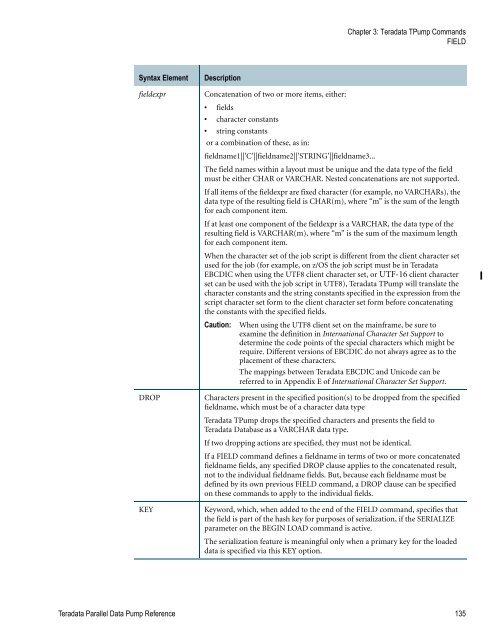Teradata Parallel Data Pump
Teradata Parallel Data Pump Reference - Teradata Developer ...
Teradata Parallel Data Pump Reference - Teradata Developer ...
- No tags were found...
Create successful ePaper yourself
Turn your PDF publications into a flip-book with our unique Google optimized e-Paper software.
Chapter 3: <strong>Teradata</strong> T<strong>Pump</strong> Commands<br />
FIELD<br />
Syntax Element<br />
fieldexpr<br />
DROP<br />
KEY<br />
Description<br />
Concatenation of two or more items, either:<br />
• fields<br />
• character constants<br />
• string constants<br />
or a combination of these, as in:<br />
fieldname1||'C'||fieldname2||'STRING'||fieldname3...<br />
The field names within a layout must be unique and the data type of the field<br />
must be either CHAR or VARCHAR. Nested concatenations are not supported.<br />
If all items of the fieldexpr are fixed character (for example, no VARCHARs), the<br />
data type of the resulting field is CHAR(m), where “m” is the sum of the length<br />
for each component item.<br />
If at least one component of the fieldexpr is a VARCHAR, the data type of the<br />
resulting field is VARCHAR(m), where “m” is the sum of the maximum length<br />
for each component item.<br />
When the character set of the job script is different from the client character set<br />
used for the job (for example, on z/OS the job script must be in <strong>Teradata</strong><br />
EBCDIC when using the UTF8 client character set, or UTF-16 client character<br />
set can be used with the job script in UTF8), <strong>Teradata</strong> T<strong>Pump</strong> will translate the<br />
character constants and the string constants specified in the expression from the<br />
script character set form to the client character set form before concatenating<br />
the constants with the specified fields.<br />
Caution: When using the UTF8 client set on the mainframe, be sure to<br />
examine the definition in International Character Set Support to<br />
determine the code points of the special characters which might be<br />
require. Different versions of EBCDIC do not always agree as to the<br />
placement of these characters.<br />
The mappings between <strong>Teradata</strong> EBCDIC and Unicode can be<br />
referred to in Appendix E of International Character Set Support.<br />
Characters present in the specified position(s) to be dropped from the specified<br />
fieldname, which must be of a character data type<br />
<strong>Teradata</strong> T<strong>Pump</strong> drops the specified characters and presents the field to<br />
<strong>Teradata</strong> <strong>Data</strong>base as a VARCHAR data type.<br />
If two dropping actions are specified, they must not be identical.<br />
If a FIELD command defines a fieldname in terms of two or more concatenated<br />
fieldname fields, any specified DROP clause applies to the concatenated result,<br />
not to the individual fieldname fields. But, because each fieldname must be<br />
defined by its own previous FIELD command, a DROP clause can be specified<br />
on these commands to apply to the individual fields.<br />
Keyword, which, when added to the end of the FIELD command, specifies that<br />
the field is part of the hash key for purposes of serialization, if the SERIALIZE<br />
parameter on the BEGIN LOAD command is active.<br />
The serialization feature is meaningful only when a primary key for the loaded<br />
data is specified via this KEY option.<br />
<strong>Teradata</strong> <strong>Parallel</strong> <strong>Data</strong> <strong>Pump</strong> Reference 135









